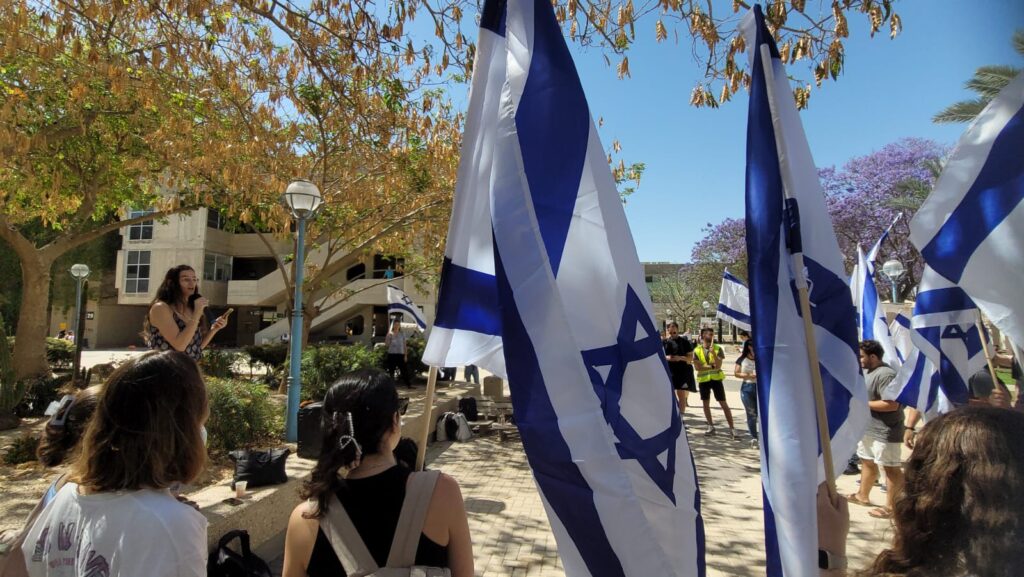Budrus is a documentary that was released in 2009. The film focuses on the anti-Security Fence movement growing in the village of Budrus, located in the West Bank. The anti-Security Fence movement is a series of protests which often start as nonviolent demonstrations but often end with throwing rocks. These protests are meant to urge the Israeli government to change the path of the security fence so it does not uproot olive trees or cross into Palestinian territory.
Julia Bacha wrote and directed Budrus. Bacha is a Brazilian filmmaker and media strategist who was educated at Columbia University. The job of a media strategist is to ensure that a certain message is conveyed in media, which means that the slant in Budrus was not accidental. Bacha now works for Just Vision which has produced films such as, Budrus, My Neighborhood, Encounter Point and Home Front, all of which have a very clear anti-Israel slant.
According to Just Vision’s website, “Just Vision highlights the power and potential of Palestinians and Israelis working to end the occupation and build a future of freedom, dignity, equality and human security using nonviolent means.” Just Vision promotes other organizations such as B’Tselem and Women in Black.
Ayed Morrar, the film’s narrator, is a community leader who often organizes nonviolent demonstrations. Morrar is accompanied by Ahmed Awwad, a Hamas activist. The film attempts to show the audience that these two men are the victims and the nonviolent activists and that the soldiers are led by brutes and thus behave in a barbaric manner. The film also tries to show the people of Budrus as the true victims.
Budrus not only shows Palestinian protesters, but Israeli and foreign protesters as well. This angle attempts to give the movement against the destruction of Palestinian land some sort of validity. However, these international protesters mainly serve as a hindrance to the IDF and not in a helpful way. These international “friends” of the Palestinians often taunted the soldiers and escalated the problems, making it worse for the people of Budrus. The violent response demonstrations increased as the international protesters forced the Israel Defense Forces (IDF) to take more drastic measures, making Israel seem like the aggressor.
This film also shows these protests from the perspective of the IDF soldiers who were serving at the border at the time. While the film paints the IDF and its tactics with civilians as harsh, two of the soldiers, Doron Spielman and Yasmine Levy, are seen as civilized. Spielman discusses the purpose of the fence and its realities, as well as the nature of IDF soldiers, whereas Levy discussed the relationship between the soldiers and the Palestinians and how that relates to the army’s orders.
Spielman acknowledged that the fence’s background was rooted in the intifada, saying, “…and that’s what we’re up against and the answer is a fence. The answer is not going out and mulling down people.”
While the film’s multicultural approach makes it seem like a fair and balanced piece, this is not the reality of the film. The film itself contains shocking language and scenes, in addition to heavily edited footage and a clear bias.
One of the more shocking tends in the film is that the words “Jew” and “Israeli” are used interchangeably. At one point, Awwad discusses how shocked he is that a Jew would stand by his side to fight another Jew. Then, in the next sentence, he goes back to using the word “Israeli.” This is troubling because it not only shows the assumption that all Israelis are Jews, but that Jews are the enemy. This interchangable use gives an anti-Semetic tone to the film.
The film also contains contradictory information that is evident in two main forms. First, in a scene with Morrar’s family, Morrar states that only men will be going to protest that day and that the co-ed march will be held the next day. Not more than 30 seconds after that sentence, his daughter, Iltizam, states that marches are always co-ed.
The other contradictory point in the film is that, despite the fact that Morrar and Awwad, as well as several other protesters, constantly insist that the protests are strictly nonviolent, there is a lot of footage that shows protesters throwing rocks. Though it is usually followed by a cry to stop, the rock throwing is evident of violent intentions. This contrast shows the filmmakers are ignoring these acts of violence in order to push the message that all Palestinians are victims and peaceful.
Iltizam Morrar is also a troubling character in the film. While she is passionate about her people’s land, some of the things that she says in this film can be questionable. For example, she discusses her family’s “history of resistance.”
“I’m from a family that I am proud of. We have a history of resistance. My father, uncles and grandmother are always talking about everything they did in the Intifada. When the Wall came I said, ‘Well, it’s my turn.’”
This reverence for violence is something that is never expanded upon, outside of a few more extreme quotes from Iltizam, but it seems odd that the daughter of a supposedly peace-loving man would admire someone who had so much to do with violence.
Finally, this film loses its credibility with its highly edited footage. There are various points in the film, but it is most evident in the interview with Zeev Boim, that the Israeli side is not allowed to speak. They cut the interviews to the sound bites that they want. Zeev Boim says that an Israeli activist should go on trial for helping the people in Budrus and when they reporter asks him about it, astonished, there is no response. They do not allow Boim to respond, expand on or clarify his comment.
Contributed by CAMERA Intern Rachel Wolf, a student at American University.


